

Compact Muon Solenoid
LHC, CERN
| CMS-EXO-20-010 ; CERN-EP-2023-083 | ||
| Search for inelastic dark matter in events with two displaced muons and missing transverse momentum in proton-proton collisions at $ \sqrt{s} = $ 13 TeV | ||
| CMS Collaboration | ||
| 19 May 2023 | ||
| Phys. Rev. Lett. 132 (2024) 041802 | ||
| Abstract: A search for dark matter in events with a displaced nonresonant muon pair and missing transverse momentum is presented. The analysis is performed using an integrated luminosity of 138 fb$ ^{-1} $ of proton-proton (pp) collision data at a center-of-mass energy of 13 TeV produced by the LHC in 2016--2018. No significant excess over the predicted backgrounds is observed. Upper limits are set on the product of the inelastic dark matter production cross section $ \sigma(\mathrm{p}\mathrm{p}\to \mathrm{A}' \to \chi_1 \, \chi_2) $ and the decay branching fraction $ \mathcal{B}(\chi_2 \to \chi_1 \, \mu^{+} \, \mu^{-}) $, where A' is a dark photon and $ \chi_1 $ and $ \chi_2 $ are states in the dark sector with near mass degeneracy. This is the first dedicated collider search for inelastic dark matter. | ||
| Links: e-print arXiv:2305.11649 [hep-ex] (PDF) ; CDS record ; inSPIRE record ; HepData record ; Physics Briefing ; CADI line (restricted) ; | ||
| Figures | |
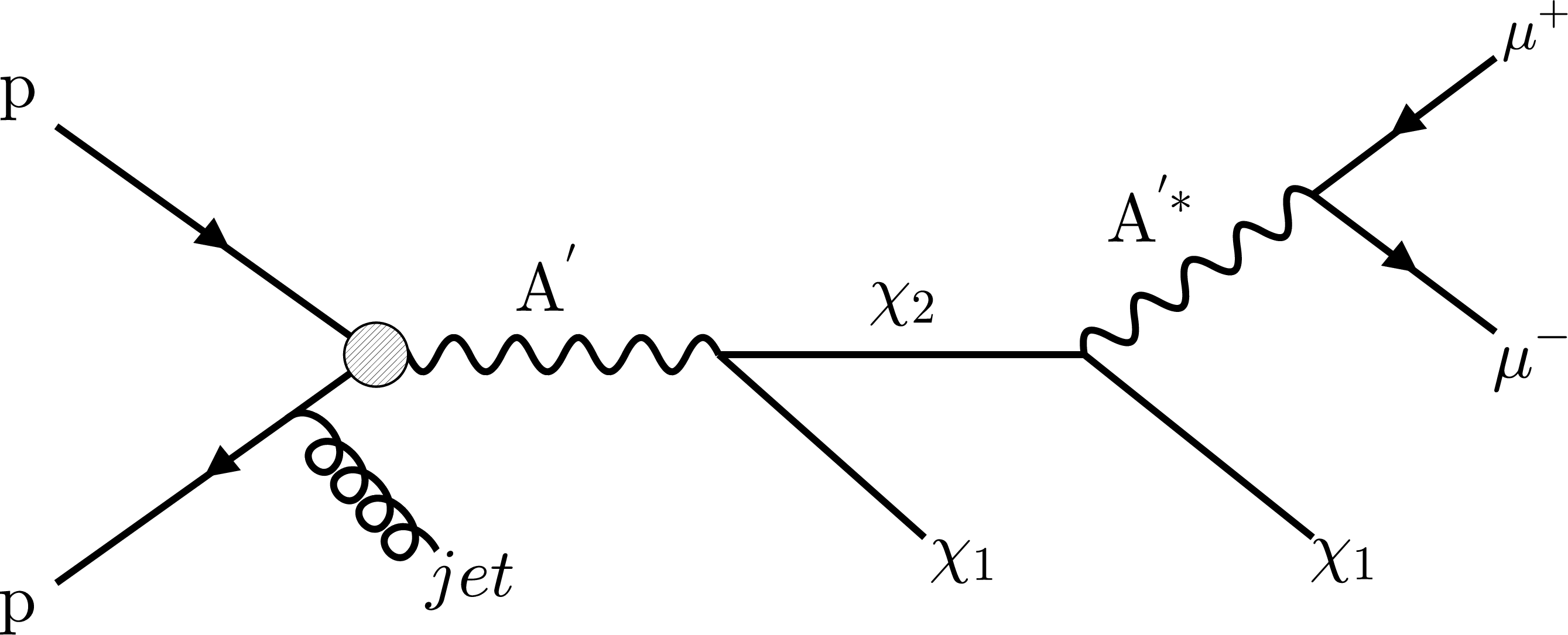
png pdf |
Figure 1:
Feynman diagram of IDM production and decay in pp collisions. The heavier DM state $ \chi_2 $ can be long-lived, and decays to $ \chi_1 $ and to a muon pair via an off-shell dark photon A'. |

png pdf |
Figure 2:
Simulated muon reconstruction efficiency of standard (blue squares) and displaced (red circles) reconstruction algorithms as a function of transverse vertex displacement $ v_{xy} $. The two dashed vertical gray lines denote the ends of the fiducial tracker and muon detector regions, respectively. |
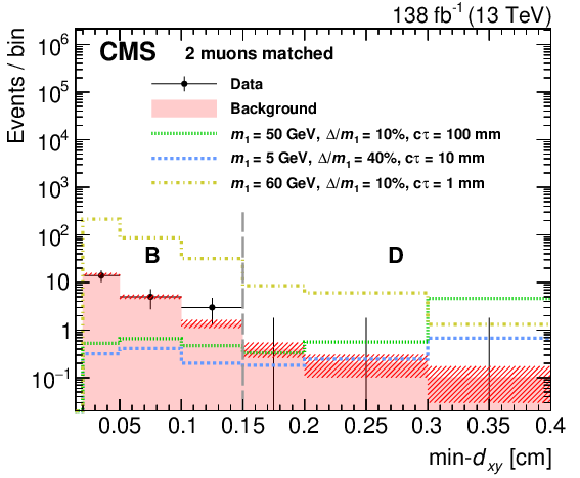
png pdf |
Figure 3:
Measured min-$d_{xy} $ distribution in the 2-match category, after requiring the min-$d_{xy} $ muon to pass the isolation requirement $ I_{\text{PF}}^{\text{rel}} < $ 0.25 (i.e.,, the B and D bins of the ABCD plane). Overlaid with a red histogram is the background predicted from the region of the ABCD plane failing the same requirement (the A and C bins), as well as three signal benchmark hypotheses (as defined in the legends), assuming $ \alpha_{\text{D}} = \alpha_{\text{EM}} $ (the fine-structure constant). The red hatched bands correspond to the background prediction uncertainty. The last bin includes the overflow. |

png pdf |
Figure 4:
Two-dimensional observed limits on $ \sigma(\mathrm{p}\mathrm{p} \to \mathrm{A}' \to \chi_1 \chi_2) \, \mathcal{B}(\chi_2 \to \chi_1 \mu^{+} \mu^{-}) $, for $ \Delta = $ 0.1 $ m_1 $ (left) and 0.4 $ m_1 $ (right), as functions of the DM mass $ m_1 $ and the interaction strength $ y $, with $ m_{\mathrm{A}'} = $ 3 $ m_1 $. Solid (dashed) curves denote the observed (expected) exclusion limits at 95% CL, with 68% CL uncertainty bands around the expectation. Regions above the curves are excluded, depending on the $ \alpha_{\text{D}} $ hypothesis: $ \alpha_{\text{D}} = \alpha_{\text{EM}} $ (dark blue) or 0.1 (light magenta). |
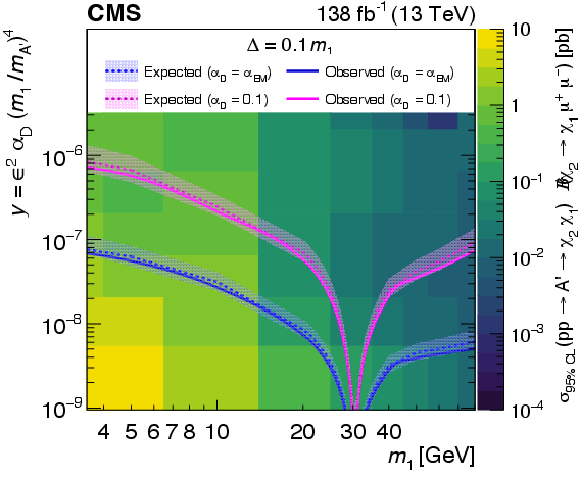
png pdf |
Figure 4-a:
Two-dimensional observed limits on $ \sigma(\mathrm{p}\mathrm{p} \to \mathrm{A}' \to \chi_1 \chi_2) \, \mathcal{B}(\chi_2 \to \chi_1 \mu^{+} \mu^{-}) $, for $ \Delta = $ 0.1 $ m_1 $, as functions of the DM mass $ m_1 $ and the interaction strength $ y $, with $ m_{\mathrm{A}'} = $ 3 $ m_1 $. Solid (dashed) curves denote the observed (expected) exclusion limits at 95% CL, with 68% CL uncertainty bands around the expectation. Regions above the curves are excluded, depending on the $ \alpha_{\text{D}} $ hypothesis: $ \alpha_{\text{D}} = \alpha_{\text{EM}} $ (dark blue) or 0.1 (light magenta). |
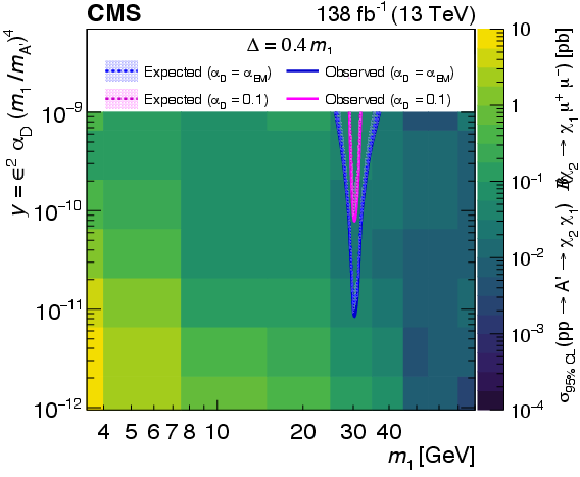
png pdf |
Figure 4-b:
Two-dimensional observed limits on $ \sigma(\mathrm{p}\mathrm{p} \to \mathrm{A}' \to \chi_1 \chi_2) \, \mathcal{B}(\chi_2 \to \chi_1 \mu^{+} \mu^{-}) $, for $ \Delta = $ 0.4 $ m_1 $, as functions of the DM mass $ m_1 $ and the interaction strength $ y $, with $ m_{\mathrm{A}'} = $ 3 $ m_1 $. Solid (dashed) curves denote the observed (expected) exclusion limits at 95% CL, with 68% CL uncertainty bands around the expectation. Regions above the curves are excluded, depending on the $ \alpha_{\text{D}} $ hypothesis: $ \alpha_{\text{D}} = \alpha_{\text{EM}} $ (dark blue) or 0.1 (light magenta). |
| Tables | |

png pdf |
Table 1:
Definition of ABCD bins and yields in data, per match category. The predicted yield in the bin with the smallest backgrounds (bin D) is extracted from the simultaneous four-bin fit by assuming zero signal, which corresponds to (Obs. B) $\times$ (Obs. C) $ / $ (Obs. A) in this limit. |
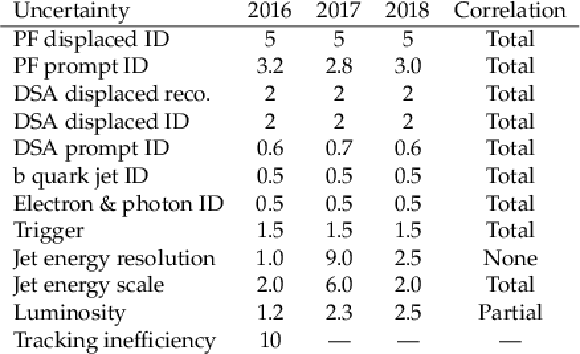
png pdf |
Table 2:
Systematic uncertainties in the analysis, in percent. The jet uncertainties are larger in 2017 because of noise issues with the ECAL endcap. The tracking inefficiency in 2016 is caused by the unexpected saturation of photodiode signals in the tracker. |
| Summary |
| In summary, a search has been presented for inelastically coupled dark matter (DM) with a unique final-state signature including a soft, displaced muon pair collimated with the missing transverse momentum vector. The analysis is performed using proton-proton collision data produced by the LHC at a center-of-mass energy of 13 TeV and collected with the CMS experiment in 2016-2018. The data sample corresponds to an integrated luminosity of 138 fb$ ^{-1} $. Control samples in data are used to predict the background, and no significant excess is observed over standard model expectations. Upper limits are set on the product of the DM production cross section and decay branching fraction into muons as a function of DM mass $ m_1 $ and interaction strength. This is the first dedicated collider search for inelastic dark matter and it significantly expands the sensitivity to $ m_1 $ above the GeV scale. |
| References | ||||
| 1 | A. Arbey and F. Mahmoudi | Dark matter and the early Universe: A review | Prog. Part. Nucl. Phys. 119 (2021) 103865 | 2104.11488 |
| 2 | D. Clowe, A. Gonzalez, and M. Markevitch | Weak-lensing mass reconstruction of the interacting cluster 1E 0657-558: Direct evidence for the existence of dark matter | Astrophys. J. 604 (2004) 596 | astro-ph/0312273 |
| 3 | E. Komatsu et al. | Five-year Wilkinson Microwave Anisotropy Probe observations: Cosmological interpretation | Astrophys. J. Suppl. 180 (2009) 330 | 0803.0547 |
| 4 | Fermi-LAT Collaboration | Searching for dark matter annihilation from Milky Way dwarf spheroidal galaxies with six years of Fermi Large Area Telescope data | PRL 115 (2015) 231301 | 1503.02641 |
| 5 | Planck Collaboration | Planck 2018 results. VI. Cosmological parameters | Astron. Astrophys. 641 (2020) A6 | 1807.06209 |
| 6 | M. Schumann | Direct detection of WIMP dark matter: concepts and status | JPG 46 (2019) 103003 | 1903.03026 |
| 7 | LUX Collaboration | Results from a search for dark matter in the complete LUX exposure | PRL 118 (2017) 021303 | 1608.07648 |
| 8 | XENON Collaboration | Search for inelastic scattering of WIMP dark matter in XENON1T | PRD 103 (2021) 063028 | 2011.10431 |
| 9 | SuperCDMS Collaboration | Results from the Super Cryogenic Dark Matter Search Experiment at Soudan | PRL 120 (2018) 061802 | 1708.08869 |
| 10 | ATLAS Collaboration | Constraints on mediator-based dark matter and scalar dark energy models using $ \sqrt{s} = $ 13 TeV pp collision data collected by the ATLAS detector | JHEP 05 (2019) 142 | 1903.01400 |
| 11 | ATLAS Collaboration | Search for new phenomena in events with an energetic jet and missing transverse momentum in $ pp $ collisions at $ \sqrt{s}= $ 13 TeV with the ATLAS detector | PRD 103 (2021) 112006 | 2102.10874 |
| 12 | CMS Collaboration | Search for new particles in events with energetic jets and large missing transverse momentum in proton-proton collisions at $ \sqrt{s} = $ 13 TeV | JHEP 11 (2021) 153 | CMS-EXO-20-004 2107.13021 |
| 13 | ATLAS Collaboration | Search for dark matter produced in association with a standard model Higgs boson decaying into b-quarks using the full Run 2 dataset from the ATLAS detector | JHEP 11 (2021) 209 | 2108.13391 |
| 14 | ATLAS Collaboration | Combination of searches for invisible decays of the Higgs boson using 139 fb$ ^{-1} $ of proton-proton collision data at $ \sqrt{s} = $ 13 TeV collected with the ATLAS experiment | PLB 842 (2023) 137963 | 2301.10731 |
| 15 | CMS Collaboration | A search for decays of the Higgs boson to invisible particles in events with a top-antitop quark pair or a vector boson in proton-proton collisions at $ \sqrt{s} = $ 13 TeV | 3, . . In proofs, 2023 | CMS-HIG-21-007 2303.01214 |
| 16 | ATLAS Collaboration | Search for long-lived particles in final states with displaced dimuon vertices in $ pp $ collisions at $ \sqrt{s}= $ 13 TeV with the ATLAS detector | PRD 99 (2019) 012001 | 1808.03057 |
| 17 | ATLAS Collaboration | Search for displaced vertices of oppositely charged leptons from decays of long-lived particles in $ pp $ collisions at $ \sqrt {s} = $ 13 tev with the ATLAS detector | PLB 801 (2020) 135114 | 1907.10037 |
| 18 | J. Alimena et al. | Searching for long-lived particles beyond the standard model at the Large Hadron Collider | JPG 47 (2020) 090501 | 1903.04497 |
| 19 | ATLAS Collaboration | Search for light long-lived neutral particles produced in pp collisions at $ \sqrt{s} = $ 13 TeV and decaying into collimated leptons or light hadrons with the ATLAS detector | EPJC 80 (2020) 450 | 1909.01246 |
| 20 | CMS Collaboration | Search for decays of stopped exotic long-lived particles produced in proton-proton collisions at $ \sqrt{s}= $ 13 TeV | JHEP 05 (2018) 127 | CMS-EXO-16-004 1801.00359 |
| 21 | LHCb Collaboration | Searches for low-mass dimuon resonances | JHEP 10 (2020) 156 | 2007.03923 |
| 22 | CMS Collaboration | Search for a narrow resonance lighter than 200 GeV decaying to a pair of muons in proton-proton collisions at $ \sqrt{s}= $ 13 TeV | PRL 124 (2020) 131802 | CMS-EXO-19-018 1912.04776 |
| 23 | CMS Collaboration | Search for long-lived particles using displaced jets in proton-proton collisions at $ \sqrt{s} = $ 13 TeV | PRD 104 (2021) 012015 | CMS-EXO-19-021 2012.01581 |
| 24 | CMS Collaboration | Search for long-lived particles decaying into muon pairs in proton-proton collisions at $ \sqrt{s} = $ 13 TeV collected with a dedicated high-rate data stream | JHEP 04 (2022) 062 | CMS-EXO-20-014 2112.13769 |
| 25 | CMS Collaboration | Search for long-lived particles decaying to leptons with large impact parameter in proton-proton collisions at $ \sqrt{s} = $ 13 TeV | EPJC 82 (2022) 153 | CMS-EXO-18-003 2110.04809 |
| 26 | CMS Collaboration | Search for long-lived particles decaying to a pair of muons in proton-proton collisions at $ \sqrt{s} = $ 13 TeV | JHEP 05 (2023) 228 | CMS-EXO-21-006 2205.08582 |
| 27 | K. Griest and D. Seckel | Three exceptions in the calculation of relic abundances | PRD 43 (1991) 3191 | |
| 28 | J. Edsjö and P. Gondolo | Neutralino relic density including coannihilations | PRD 56 (1997) 1879 | hep-ph/9704361 |
| 29 | E. Izaguirre, G. Krnjaic, and B. Shuve | Discovering inelastic thermal-relic dark matter at colliders | PRD 93 (2016) 063523 | 1508.03050 |
| 30 | A. Berlin and F. Kling | Inelastic dark matter at the LHC lifetime frontier: ATLAS, CMS, LHCb, CODEX-b, FASER, and MATHUSLA | PRD 99 (2019) 015021 | 1810.01879 |
| 31 | D. Smith and N. Weiner | Inelastic dark matter | PRD 64 (2001) 043502 | hep-ph/0101138 |
| 32 | B. Holdom | Two U(1)'s and epsilon charge shifts | PLB 166 (1986) 196 | |
| 33 | B. Batell, R. Essig, and Z. Surujon | Strong constraints on sub-GeV dark sectors from SLAC beam dump E137 | PRL 113 (2014) 171802 | 1406.2698 |
| 34 | E. Izaguirre, Y. Kahn, G. Krnjaic, and M. Moschella | Testing light dark matter coannihilation with fixed-target experiments | PRD 96 (2017) 055007 | 1703.06881 |
| 35 | M. Mongillo et al. | Constraining light thermal inelastic dark matter with NA64 | EPJC 83 (2023) 391 | 2302.05414 |
| 36 | J. D. Bjorken et al. | Search for neutral metastable penetrating particles produced in the SLAC beam dump | PRD 38 (1988) 3375 | |
| 37 | LSND Collaboration | Measurement of electron-neutrino electron elastic scattering | PRD 63 (2001) 112001 | hep-ex/0101039 |
| 38 | A. Hook, E. Izaguirre, and J. G. Wacker | Model independent bounds on kinetic mixing | Adv. High Energy Phys. 2011 (2011) 859762 | 1006.0973 |
| 39 | BaBar Collaboration | Search for invisible decays of a dark photon produced in $ {e}^{+}{e}^{-} $ collisions at BaBar | PRL 119 (2017) 131804 | 1702.03327 |
| 40 | H. Baer, V. Barger, and P. Huang | Hidden SUSY at the LHC: the light higgsino-world scenario and the role of a lepton collider | JHEP 11 (2011) 031 | 1107.5581 |
| 41 | Z. Han, G. D. Kribs, A. Martin, and A. Menon | Hunting quasidegenerate higgsinos | PRD 89 (2014) 075007 | 1401.1235 |
| 42 | CMS Collaboration | HEPData record for this analysis | link | |
| 43 | ATLAS Collaboration | Search for heavy neutral leptons in decays of $ W $ bosons using a dilepton displaced vertex in $ \sqrt{s}= $ 13 TeV $ pp $ collisions with the ATLAS detector | PRL 131 (2023) 061803 | 2204.11988 |
| 44 | CMS Collaboration | The CMS experiment at the CERN LHC | JINST 3 (2008) S08004 | |
| 45 | CMS Collaboration | Particle-flow reconstruction and global event description with the CMS detector | JINST 12 (2017) P10003 | CMS-PRF-14-001 1706.04965 |
| 46 | J. Alwall et al. | The automated computation of tree-level and next-to-leading order differential cross sections, and their matching to parton shower simulations | JHEP 07 (2014) 079 | 1405.0301 |
| 47 | J. Alwall et al. | Comparative study of various algorithms for the merging of parton showers and matrix elements in hadronic collisions | EPJC 53 (2007) 473 | 0706.2569 |
| 48 | T. Sjöstrand et al. | An introduction to PYTHIA 8.2 | Comput. Phys. Commun. 191 (2015) 159 | 1410.3012 |
| 49 | CMS Collaboration | Event generator tunes obtained from underlying event and multiparton scattering measurements | EPJC 76 (2016) 155 | CMS-GEN-14-001 1512.00815 |
| 50 | CMS Collaboration | Extraction and validation of a new set of CMS PYTHIA8 tunes from underlying-event measurements | EPJC 80 (2020) 4 | CMS-GEN-17-001 1903.12179 |
| 51 | R. D. Ball et al. | Parton distributions for the LHC Run II | JHEP 04 (2015) 40 | 1410.8849 |
| 52 | R. D. Ball et al. | Parton distributions from high-precision collider data | EPJC 77 (2017) 663 | 1706.00428 |
| 53 | GEANT4 Collaboration | GEANT 4\textemdash a simulation toolkit | NIM A 506 (2003) 250 | |
| 54 | CMS Collaboration | The CMS trigger system | JINST 12 (2017) P01020 | CMS-TRG-12-001 1609.02366 |
| 55 | CMS Collaboration | Identification of heavy-flavour jets with the cms detector in pp collisions at 13 tev | JINST 13 (2017) P05011 | CMS-BTV-16-002 1712.07158 |
| 56 | CMS Collaboration | Performance summary of AK4 jet b tagging with data from proton-proton collisions at 13 TeV with the CMS detector | CMS Detector Performance Note CMS-DP-2023-005, 2023 CDS |
|
| 57 | CMS Collaboration | Performance of the CMS muon detector and muon reconstruction with proton-proton collisions at $ \sqrt{s} = $ 13 TeV | JINST 13 (2018) P06015 | CMS-MUO-16-001 1804.04528 |
| 58 | R. Frühwirth | Application of Kalman filtering to track and vertex fitting | NIM A 262 (1987) 444 | |
| 59 | CMS Collaboration | Search for long-lived particles using delayed photons in proton-proton collisions at $ \sqrt{s} = $ 13 TeV | PRD 100 (2019) 112003 | CMS-EXO-19-005 1909.06166 |
| 60 | CMS Collaboration | Precision luminosity measurement in proton-proton collisions at $ \sqrt{s} = $ 13 tev in 2015 and 2016 at CMS | EPJC 81 (2021) 800 | CMS-LUM-17-003 2104.01927 |
| 61 | CMS Collaboration | CMS luminosity measurement for the 2017 data-taking period at $ \sqrt{s} = $ 13 TeV | CMS Physics Analysis Summary, 2018 CMS-PAS-LUM-17-004 |
CMS-PAS-LUM-17-004 |
| 62 | CMS Collaboration | CMS luminosity measurement for the 2018 data-taking period at $ \sqrt{s} = $ 13 TeV | CMS Physics Analysis Summary, 2019 CMS-PAS-LUM-18-002 |
CMS-PAS-LUM-18-002 |
| 63 | T. Junk | Confidence level computation for combining searches with small statistics | NIM A 434 (1999) 435 | hep-ex/9902006 |
| 64 | A. L. Read | Presentation of search results: the CL$ _{\text{s}} $ technique | JPG 28 (2002) 2693 | |

|
Compact Muon Solenoid LHC, CERN |

|

|

|

|

|

|